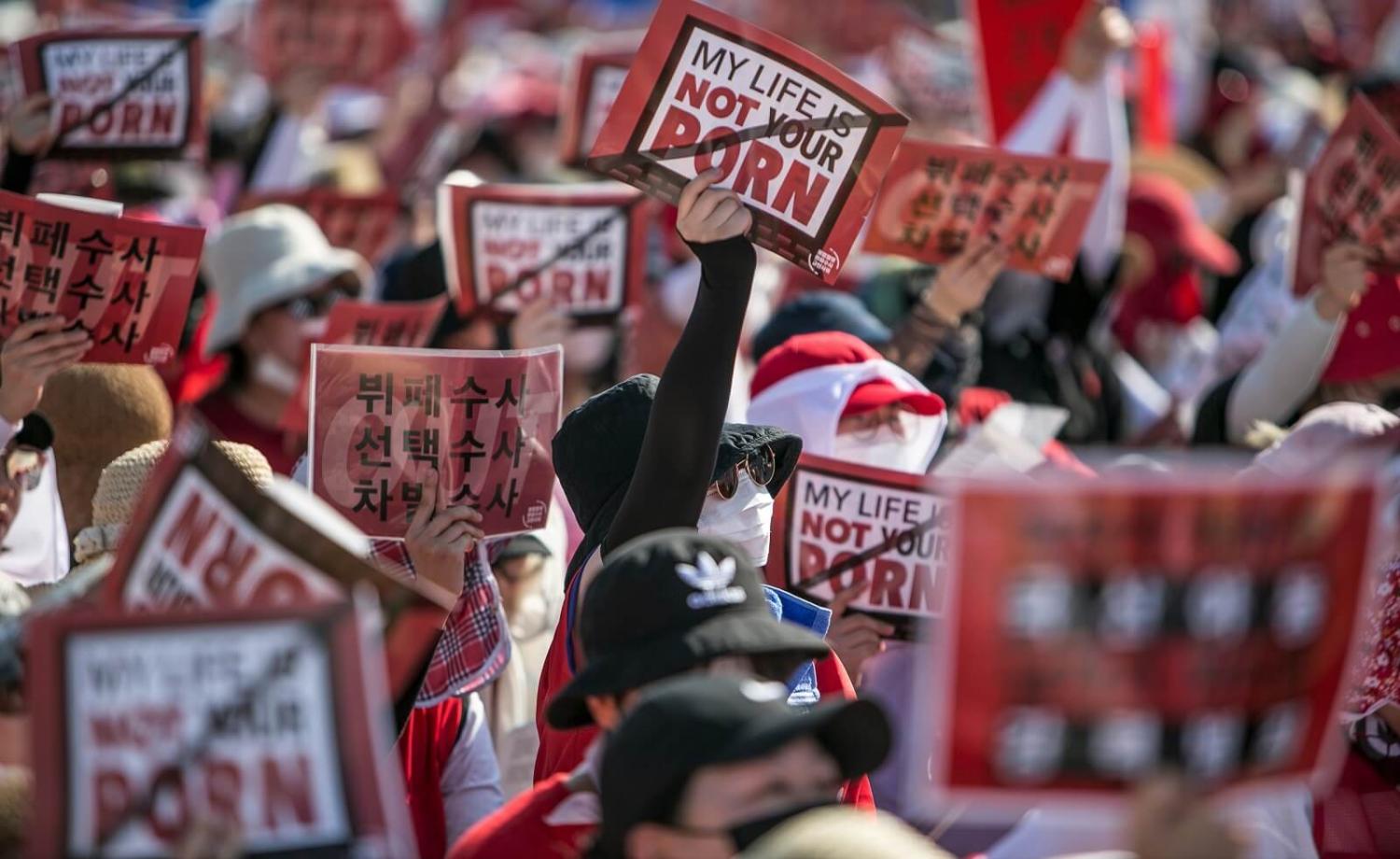One recent Saturday in August, in the middle of a heatwave with the temperature hitting 35 degrees, 70,000 women gathered in the streets of Seoul. The numbers were unprecedented, but the action wasn’t. They have been staging regular rallies since May, in what has been called the biggest recorded women’s movement in South Korea’s history.
The overwhelming majority of suspects are men, and the overwhelming majority of victims are women.
The women, many wearing masks and some bearing signs declaring “My life is not your porn”, were gathering to protest molka – the use of hidden cameras to take images and videos, usually of a sexual nature, for distribution online – and to demand better policing and harsher penalties for those found guilty.
The catalyst for the grass-roots action was the arrest of a woman for the same crime: she had uploaded a video of a nude male model she secretly recorded during a drawing class at Hongik University. She was quickly arrested, her camera confiscated, and police presented her proudly to the media (although she was allowed to wear a mask).
These events angered many women and served as a call to action: the overwhelming majority of molka suspects are men, and the overwhelming majority of its victims are women.
“Unlike most illegal filming cases where the victims were female, illegal filming against the male nude model gained massive attention from the start,” an organiser from Women March for Justice told web news magazine Korea Exposé after the first protest on 19 May which attracted 12,000 women. “The police reacted promptly and effectively, which was unprecedented, victim-oriented policing.”
Police said the woman was arrested not because she was female, but because they feared she was a flight risk, and that she might destroy evidence. On August 13, the woman was sentenced to a 10-month prison sentence, while a man in Busan, charged with similar offences against the woman, was fined $2000.
Molka (the word comes from a 1990s Candid Camera–style prank show) is not new, but advances in technology have made it more prevalent. Now, everyone has the ability to take photos or video with their smartphones, and tiny cameras are sold in items such as ties, pens, water bottles, spectacles, shoes, and belts.
Molka material commonly ranges from “upskirt” images, taken while a woman is walking up crowded subway stairs, to video recorded by hidden cameras in public toilets.
Once a video or photo has been uploaded to the web, it is difficult to remove. The material proliferates on social media and websites such as South Korea’s infamous Soranet, where many gathered not only to view revenge porn and other illicitly shared images but also to plan sex crimes. Soranet was finally shut down in 2016, but other sites have sprung up in its place.
Demand for this material should not be mistaken for acceptance, and victims can lose their jobs and social status. Those who are wealthy can pay a fee of $3000 a month for an agency to track and remove videos from the web. Others, such as the organisers of the protests and the 44,000 members of their online community, agitate for change, and wonder whether they should speak openly and risk being abused online or worse, or to remain anonymous.
Organisers say issues lie not only at a policing level but also with the judiciary. When convictions are recorded, fines can be paltry: the maximum is $9000, but in reality perpetrators often pay much less. Only about 5% serve jail time. The number of molka cases rose from 1354 in 2011 to 5363 in 2017. More than 95% of suspects were men.
South Korean President Moon Jae-in has called for tougher penalties, and on 7 August the Ministry of Gender Equality and Family announced measures aimed at stamping out cameras in bathrooms, including funding for detection in schools, public toilets, and toilets of private companies, as well as airports and bus and train terminals. Figures from government reports show 24% of all spycam-related crime takes place at busy transport hubs.
Meanwhile, protesters aren’t the only community activists getting involved. Some businesses had already taken matters into their own hands by joining a voluntary project named Red Circle, started by Southern Gyeonggi police and students from Kwangwoon University. Businesses, such as cafes, display posters declaring their premises free of spycams, and distribute red stickers that highlight a phone’s camera. K-pop stars Kim Junsu (also known as Xia) and Kim Hyung-jun (from the band SS501), who are both doing military service with the police department, have supported the initiative by creating socila media videos of themselves visiting participating businesses, including one run by a woman who joined the project because she had been a victim.
The Red Circle campaign is obviously worthy of support, but women’s causes are not embraced by everyone in South Korea, and pop stars have been harshly criticised for much less. A survey of 1000 people carried out by the Korea Press Foundation found that only 50% of women and 20% of men supported the protesters’ cause.
But these marches have harnessed the momentum of the #MeToo movement kickstarted earlier this year in South Korea, when a high-ranking woman in the judiciary spoke publicly about the sexual harassment she had experienced in her position. It led to a string of high-profile men being ousted from their positions as women’s stories were finally given credence.
Change is never easy, but as this rapidly growing movement shows, it is on its way, whether some sectors of society like it or not. Hopefully it will only be a matter of time until molka, like the Candid Camera show itself, is an outdated relic of the past.

